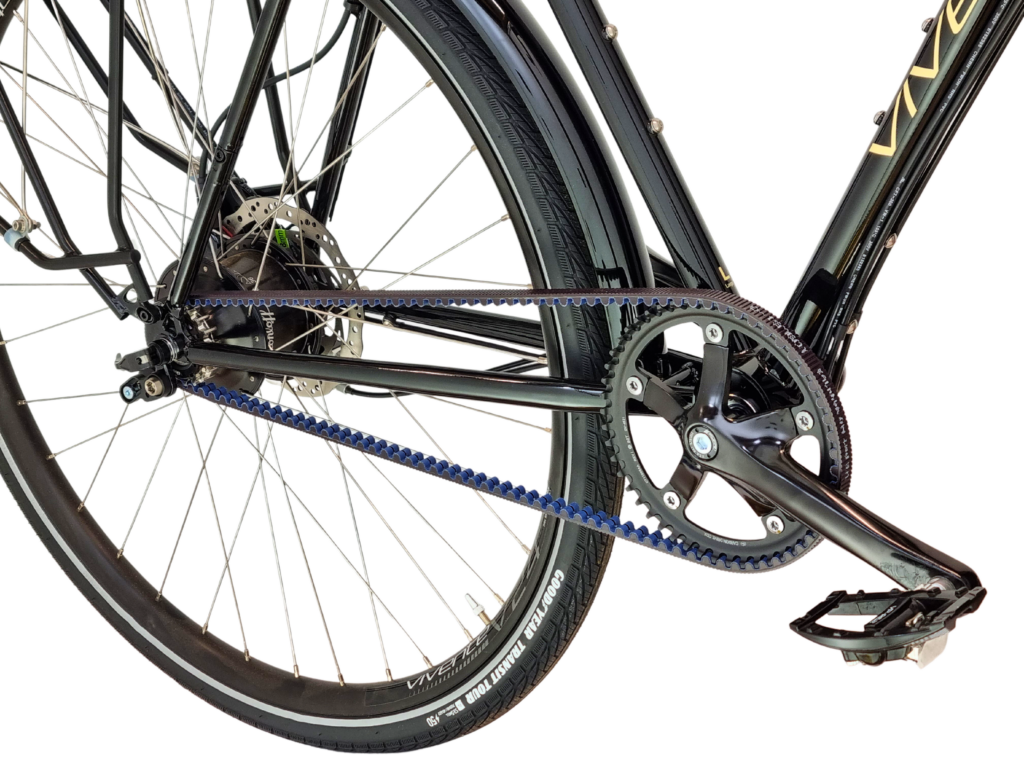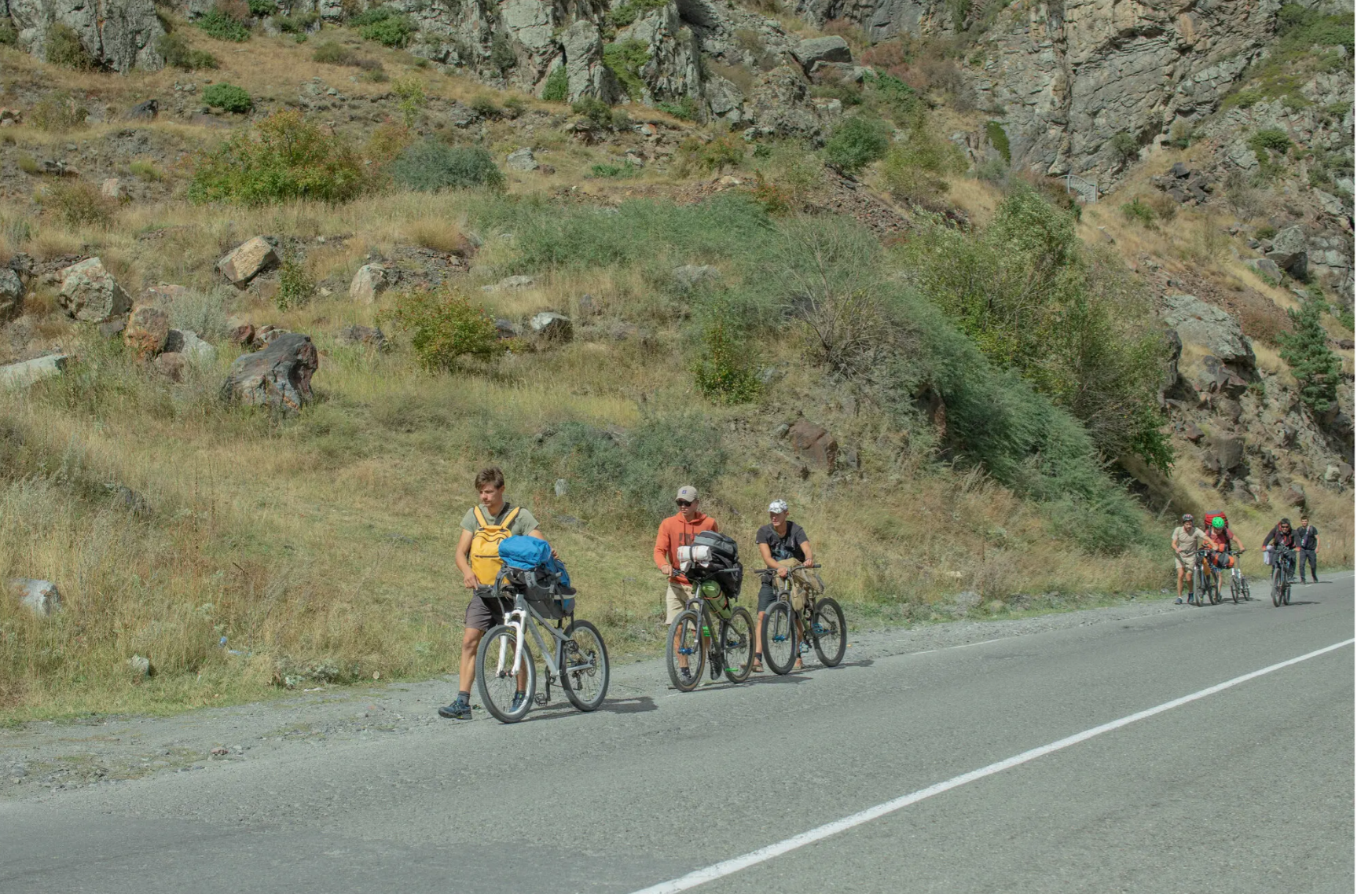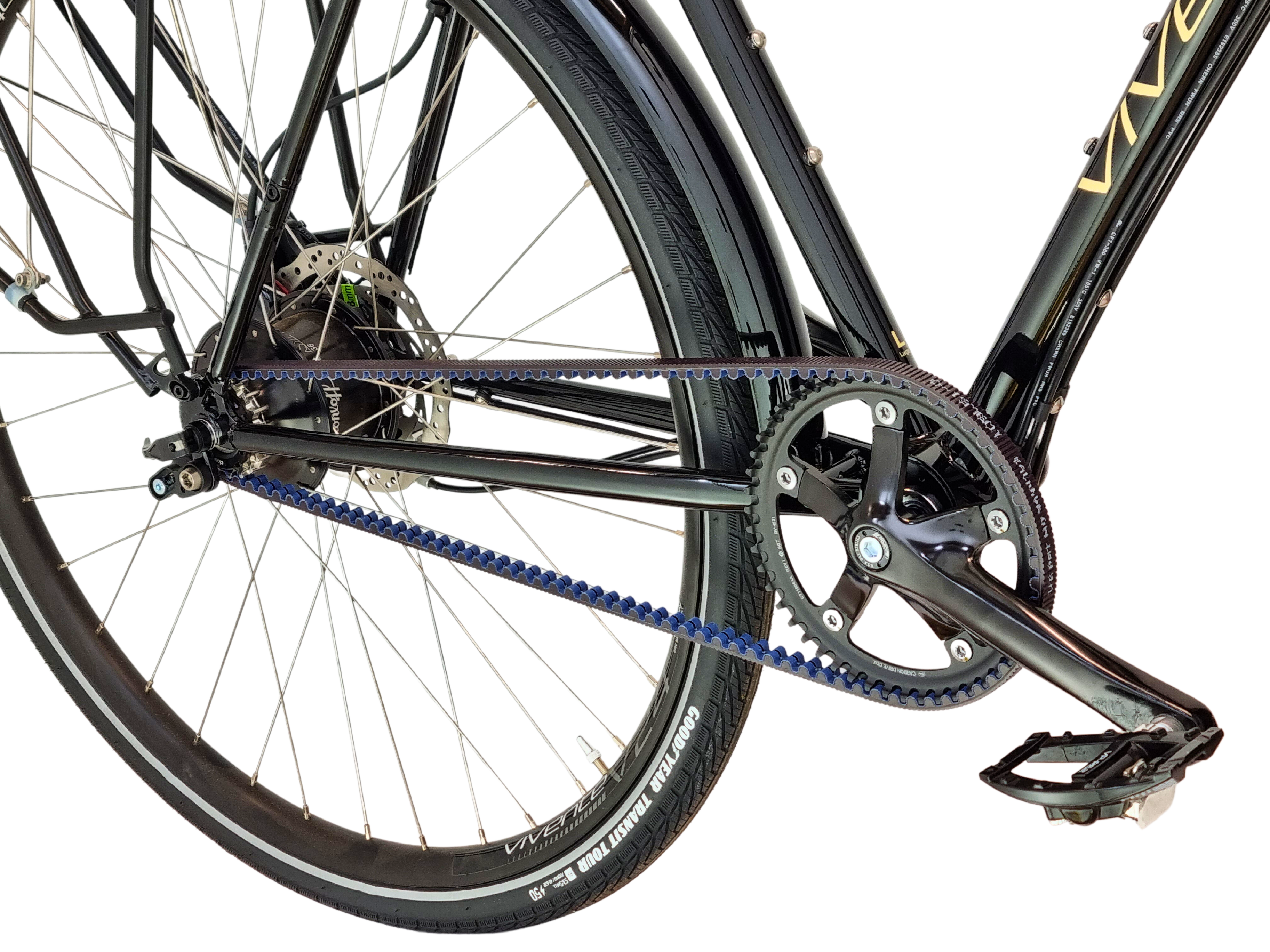
About Touring Bike Gear Systems and Measurement
Essentially, a gear system allows you to vary the number of times you need to turn the pedals for a given distance travelled. Because each turn gives you an extra push of the pedals, when climbing or in headwinds, using low gears, you can turn the pedals more times and strain less per turn. Or you can travel further with each turn in the high gears. A good touring bike gear system is integral to bicycle travel.
You need your low gears to be low enough to allow you to get up hills whilst carrying luggage. At the same time, you don’t want to “run out of gears” on the top ratios. “Spinning out” is the term. It is great being able to still pedal if you are on a long downhill run. Some people are happy to coast but, for some, pedalling at speed is the reward after the climb.
The total range of your gears therefore should be high. There are other issues such as having even gaps between the gears, durability, weight, serviceability including availability of replacement bits in the long term., A touring bike gear system should have a range of at least 500%. If you mark the distance the bike goes in top gear in one pedal rotation, the same distance in bottom gear would require at least five pedal rotations.
Gear Inches
This is a way of measuring and comparing the ratio when different combinations of front and rear sprockets and wheel diameters are used. Leaving bikes with internal hubs out for a moment…
gear inches = number of teeth on the front cog, divided by the number on the rear, times the wheel diameter in inches.
But what is the wheel diameter in inches? What’s 700C, what’s 650B, what’s 29’er?
Wheel diameter in inches = the ISO of the rim + two times the width of the tyre. The total is then divided by 25.4.
A 700C rim has an ISO of 622. So does a “29er”. A 650B rim has an ISO of 584.
| Rim | ISO | Tyre | Diameter (inches) |
|---|---|---|---|
| 26″ | 559 | 44mm (1.75″) | 25.5″ |
| 700C | 622 | 32mm | 27″ |
| 700C | 622 | 40mm | 27.6″ |
| 700C | 622 | 44mm | 28″ |
| 650B | 584 | 50mm | 27″ |
| 650B | 584 | 57mm (2 – ¼”) | 27.5″ |
For decades, a discussion about gear inches on touring bikes would only have been about triple chain-wheel systems. As we discuss below, this has changed due to higher-end component manufacturers walking away from the triple category.
In recent years the key component makers have been pushing wide-range double chainwheel systems. This has been driven by the need to a low gear close to 20”. Cyclingabout has a good article on this development. The comments section reveals that no one is unhappy with triples to begin with. The move away from triples is not demand-driven.
Other gear-measuring systems
Whilst Gear Inches has been used for the longest time, a reference to how far the bike goes in a given gear (metres development) is also in common use.
Sheldon Brown has the ultimate bicycle gear ratio calculator. You can choose between gear inches or metres development for your output. When using it, select 27” (nominal) if you use 650B x 50mm. 27.5” is represented by 700c with 38mm. This also matches 650B and 2-1/4”.
The need for a low bottom gear
We come in many ages, shapes and sizes. We travel in flatter or more rugged terrain. We carry anything from very little to a lot. Therefore, we cannot generalize too much about what bottom gear is best.
But, as we expect to travel on it, our bicycle can’t be a disposable item. We want it to last and last. It should be there for us as we get older and as we take on different journeys, different terrain, different loads.
This is why the bike should have a low enough gear ratio for the journeys we hope to do later. Not just now. It should be up for what ever we are up for.
General agreement on the point of lowest ratio is that 20” is about right. Walking up hills is ok a bit. But not a lot.

This is a picture from 2022 of Russians fleeing their country, but unable to ride up the hills.
With increasing difficulty obtaining quality triple-chainwheel components (particularly the shift levers and front derailleurs), there are not many options in the derailleur-bike world where you can have 500% range or more and a bottom gear of 20”. When you find one, it is likely to be a double front.
Internal Gear Ratios
Gear ranges on Rohloff travel bikes
To achieve a low gear on a chain-gear system you need a very small front cog. Probably 24 teeth. Because of its low internal gear ratio, a Rohloff bike can have a very low gear and still have a 46 or 50 tooth front sprocket.
| Front sprocket | Rear sprocket | Ratio (external) | Lowest gear (in) | Highest gear (in) |
|---|---|---|---|---|
| 46 | 22 | 2.09 | 15.9 | 83.8 |
| 50 | 22 | 2.27 | 17.3 | 91.1 |
| 46 | 19 | 2.42 | 18.5 | 97.0 |
| 50 | 19 | 2.63 | 20.1 | 105.5 |
| Front sprocket 50 Rear sprocket 19 | Front sprocket 46 Rear sprocket 19 | Front sprocket 50 Rear sprocket 22 | Front sprocket 46 Rear sprocket 22 | |
|---|---|---|---|---|
| External ratio | 2.63 | 2.42 | 2.27 | 2.09 |
| Internal ration in 1st | 0.279 | 0.279 | 0.279 | 0.279 |
| Internal ratio in 14th | 1.467 | 1.467 | 1.467 | 1.467 |
| Low gear (27″ wheel diameter) | 19.8 | 18.2 | 17.1 | 15.8 |
| Top gear (27″ wheel diameter) | 104.2 | 95.9 | 90.0 | 82.8 |
| Low gear (27.5″ wheel diameter) | 20.2 | 18.6 | 17.4 | 16.0 |
| Top gear (27.5″ wheel diameter) | 106.2 | 97.7 | 91.7 | 84.4 |
The 50:19 set-up with a top gear of 105.5 suits a lot of people. If, however, you would pass up on that top gear, you could run 46:19 and come down to a low of 18.5”. And so it goes. You must also take luggage and terrain into account.
Being able to achieve these low gears, along with the smoothness of belt drive makes Rohloff/Gates a winner. (Rohloff stipulates that to use the 46:22 you cannot be over 100kg rider weight.)
Derailleur Systems – Less costly but some issues
Vivente has produced derailleur bikes like Patagonia, Anatolia and Deccan for a long time. They have been and still are popular. We all accepted that they wore out, that they were vulnerable, that bottom gears might not have been low enough and that you had to carry spares and tools. They were not too expensive.
There are only a few quality component makers of those gear parts. They decide what they will make and what shows up on bikes in the marketplace is so determined. That was always the case as the 15 speed bikes of forty years ago gradually morphed into 27 and 30 speed. But something clicked (or snapped) at the component maker HQ and the offerings of triple gear-systems got smaller and smaller. Since just before Covid it got worse.
Vivente would have used wide-range doubles decades ago if we thought they provided a good gearing solution.
Part of the way these component offerings happen is that at least some of spares for what was being pushed 5-10 years back become impossible to find. With component integration being the norm within a transmission system, not being able to replace, for example, a left shift lever can be the end of that whole system on the bike.
The chain-gear system is vulnerable, and it is subject to wear. So, parts availability is needed. This is the case for everyone but no one more so than the long-distance cyclist. Long term parts availability is a reason why the Vivente Anatolia and Deccan were discontinued.
Internal (Rohloff) Systems

The Rohloff 14sp hub such as the one on Vivente’s The Gibb and Swabia provides a gear range of 526%. By comparison, a Shimano Alfine 11sp hub gives 409% range so is considered inadequate for long distance riding.
The gears on Rohloff are all evenly spaced (13.7% from one to the next) and there are no redundant gears.
If you want, later on you can vary the level of the gears by simply changing the front, rear or both sprockets.
In the first 3,000km to 4,000km on a new Rohloff hub there is a slightly detectable drag in the lower gears. By 5,000km this not noticeable. Hub noise also reduces and after a while, in the top seven gears, it is not discernible.
Shift lever operation is very accessible, smooth and comfortable regardless of the handlebar set-up chosen.

Because you have single sprockets front and back you can use a carbon belt rather than a chain. A Gates carbon belt lasts as long as at least five chains on a derailleur bike. It needs no lubrication, can be washed with water, is very low friction, is lighter and runs almost silently.
A lot has been said in praise of Rohloff but the comment that rings the loudest to long-distance cyclists is that they wear in rather than wear out. There are many reports of people exceeding 100,000km on the same hub.
More About Rohloff Systems on Vivente Bikes
- There are claims that a Rohloff system is actually cheaper due to its longevity and low maintenance cost. Vivente test riding bears this out.
- Rohloff’s gears are inside the hub shell. It was originally built as an all-season MTB hub, for use in Northern Europe’s extreme conditions It is well sealed, and the internals run in an oil bath.
- Rohloffs are virtually maintenance free. You are supposed to drain out the oil and replace it approximately every 5,000km. It is very easy to do and fully explained on a small and lightweight kit they sell.
- Our recommendation is that when changing oil, only put in the amount you have taken out. You might not have drained it all out and by putting in the 25ml in the retail pack, you might overfill it and have oil sweat through the seals and get onto your rear disc rotor.
- Rohloffs allow you to shift gears when not pedalling. That’s very appealing if you are stopped at traffic lights or at the bottom of a hill.
- Rohloffs allow you to change through many gears at once, more easily than on chain-gear systems. With equally spaced gear ratios, the next gear is only a simple twist of the shifter away whereas on a chain-gear system it may need you to change both front and rear derailleurs. (Shifting is easier).
- With just one sprocket front and rear, Rohloffs run a straight belt line.
- Rohloff hubs have less dependence on a shifter than derailleur drivetrains have. You can even change Rohloff gears with an 8mm spanner. The “indexing” of the gears takes place inside the hub. This means that the twist grip itself is a low-tech item. There is little that could ever go wrong with it whereas on derailleur systems the shift-levers are not only critical but can get damaged.
- Rohloffs never slip or jump. This does happen on chain-gear systems to an extent and is annoying, especially if you are out of the saddle.
- Rohloff wheels are inherently stronger because they don’t have the offset needed on wheels with a cassette.
After 30-40,000km one or more of the seals inside the hub will begin to let a little oil through and some of this oil could get as far as the rear brake pads. You need to prevent this so checking and wiping any oil from around the areas where the hub connects to the frame is necessary. We use kitchen paper. This is a very gradual development. As it begins you know the time to have the seals serviced has arrived. Scattered around the globe, there is a network of technicians qualified to do this.
Efficiency of drive trains is also important. You want as much of your power as possible going to the rear tyre on the ground. This is a technical subject and there are claims and counter claims. Chester Kyle and Frank Berto published a major study on it. They found that the chain gear system was about 2% more efficient, which over a distance is a lot. However, they used a new hub. Experienced Rohloff users agree that by the time of the first oil change (4-5,000km) this initial drag virtually disappears.
Choosing the right touring bike gear system for your type of travel is essential. Use the information above to decide for yourself which you would prefer and as always feel free to contact us.